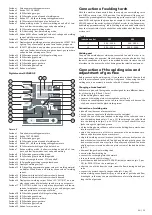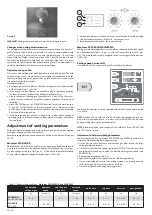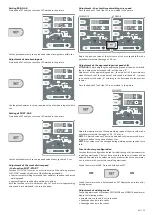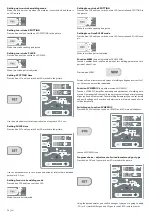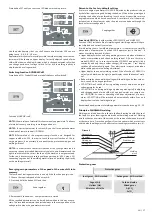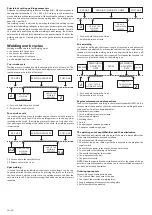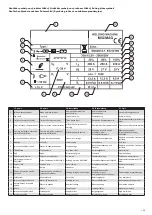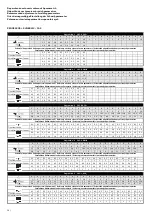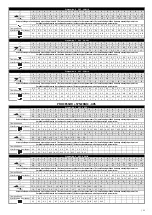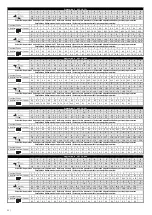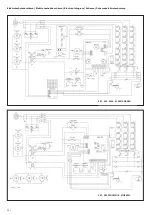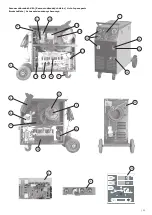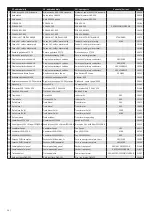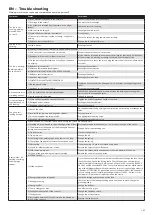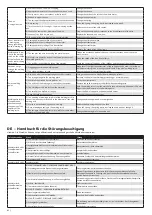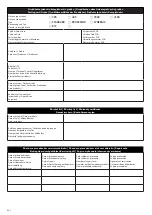
|
61
EN - Trouble shooting
Warning: machine can repair only competed and educated personal!
Symptom
Reason
Resolution
The fan is not
running, welding
machine does
not work.
1/ Is the machine connected to the network?
Connect the machine into the network.
2/ Is voltage in the socket?
You must check the socket.
3/ Is not the wire released from the clamp in the plug or
socket?
Check the socket or the plug.
4/ Main switch is damaged.
Exchange the main switch.
5/ Loose cabel from clamp in the machine.
Fix the cabel.
6/ The control trnsformer is without voltage - the phase is
missing.
Check the socket, the plug and main power cable.
7/ Defective control transformer.
Change the control transformer.
The fan is not
running.
The fan is broken.
Exchange the fan.
The fan is working,
welding machine
does not work.
A/ CONTACTOR DOES NOT SWITCH - THE FEED DOES NOT WORK
1/ Euro connector is not connected to the torch.
Connect the euro connector to the torch.
2/ Damaged switch or control cabel in the torch.
Disconnect the torch and two contacts of the bridge for controling. If all function
of the machine are working, exchange the switch, cabel or whole torch.
3/ On the controling transformer is not voltage - the phase
are missing.
Exchange the fuse, check the switch, plug and main cabel, check the phase on the
contactor.
4/ Defective coil contactor.
Exchange the contactor.
5/ Defective thermostats (see diagram).
Exchange the thermostats.
B/ CONTACTOR IS SWITCHING, FEED DOES NOT WORK
1/ Defective control electronics.
Exchange the board.
2/ Defective motor feed.
Exchange the motor feed.
C/ CONTACTOR IS SWITCHING, FEED WORKS
1/ Broken ground cable
Isolation does not need to be damaged, so it is not clear - exchange the ground
cabel.
2/ Damaged torch of coaxial cable.
Exchange the coaxial cable.
On the nozzle torch
is welding current.
1/ On the nozzle torch is accumulated spatter.
Takeoff the nozzle and clean it, as same as clean the between piece and girder,
spray the parts by separation spray.
2/ Isolation nozzle is damaged.
Take off the nozzle.
It is not possible to
regulate speed of
the feeding.
1/ Loose knob of regulation speed of the feed.
Tighten the knob of regulation speed of the feed.
2/ Damaged potenciometer.
Exchange the potenciometer.
3/ Damaged control electronics.
Exchange the board.
The gas is still
leaking by torch.
1/ Dirt on the valve.
Do the disassembly and purifying or exerts tension on the spring or exchange the
valve.
2/ Incorrectly set pressure reducing valve cylinder.
Set the pressure.
3/ It is used inappropriate throttle valve.
Use appropriate reducing valve.
4/ Damaged electromagnetic valve.
Exchange electromagnetic valve.
Badly welds – it’s
sticking, scorching,
shaking, large
spatter.
A/ BAD PASSING OF THE WIRE THROUGH THE WELDING TORCH OR DRAWING DIE
1/ Drawing die is too imbedded under the edge of the orifice. Drawing die can be imbedded only 1 – 2 mm under the edge of the orifice.
2/ The diameter of the opening of the drawing die does not
correspond to the used wire.
Change tip for corresponding one.
3/ Tip is very dirty.
Clean or change the tip.
4/ Tip is worn out.
Change the tip.
5/ The spring in the welding torch is too short or too long.
Change the spring.
6/ The spring of appropriate diameter has not been used.
Change the spring.
7/ Dirty spring.
Clean the spring – it has to be cleaned every week.
8/ Sheave for different diameter of wire.
Release the thrust of the shift sheave.
9/ Shift sheave is worn out.
Clap on the sheave which corresponds to the used diameter of the wire.
10/ Spool of the wire is being too intensely braked.
Release the screw of the spool brake.
B/ OTHER CAUSES
1/ Fallen-out phase.
Try to connect the machine to some other circuit breaker. Change the fuse, check
the socket, the plug and the flexing cable. Check if thee are on the clamp of el.
transformer after switching of welding torch all 3 phases A0 connected B0 400 V,
A0 400 V and B0 connected C0 400 V – only three phase machines. While measu
-
ring with welding machines with the alternation switch of rough voltage always in
A position. ATTENTION!, if 1 phase falls out, only voltage of about 230 V appears,
there is voltage on the clamp! Right voltage, however, is 400 V - defect is in the
contactor or in the socket or released wire on the clamp.
2/ Wrongly adjusted working point.
Check the voltage and the speed of wire feed.
3/ Wrong grounding.
Check the contact between grounding pliers and the work piece. Change the
grounding cable.
4/ Wrong rectifier.
Change the rectifier.
5/ Low - quality gas or wire.
Use different wire or gas.
6/ Faulty alteration switch of the currency.
Change the alteration switch.
7/ Faulty circuits.
Change the el. transformer.
8/ Burnt wired between el. transformer and the alteration
switch of the currency.
Replace the faulty circuit.
Summary of Contents for 305
Page 22: ... 67 ...

